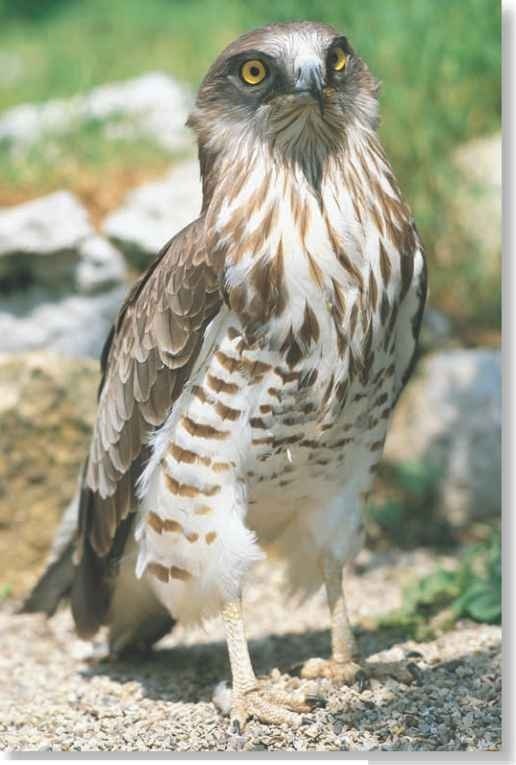ORDER
Falconiformes
FAMILY
Accipitridae
GENUS & SPECIES
KEY FEATURES
• Swallows snakes head first; tails can be seen protruding from the eagle’s mouth
• Performs an elaborate sky dance during nuptial displays, which include snake-tossing
• Hovers above its prey for long periods before parachuting down to grasp the victim on the ground
WHERE IN THE WORLD?
Found in southwest and southeast Europe, including France, Italy and Spain; also in northwest Africa east to Iran, Iraq, India, western China and the Lesser Sundas islands in Indonesia

LIFECYCLE
The short-toed snake eagle is largely a specialist hunter, searching year-round for snakes, both big and small; the young learn at an early age to swallow snakes headfirst.
Habitat
The short-toed snake eagle prefers warm, open habitats with scattered trees, meadows, forest and rocky slopes where it can nest and roost. Populations flourish not only in the
Mediterranean region, including France, Spain, and Greece, but also in Algeria, Africa, China and India.Though generally uncommon in northern Europe, the eagle has ventured as far north as Denmark during the breeding season. In warmer climates, the eagle ranges in dry plains, hills and mountains; in cooler northern climates, the bird also inhabits heaths, damp grasslands and wetland margins adjacent to forests.
Food & hunting
The short-toed snake eagle is an expert snake hunter — 7080% of its diet is made up of snakes. It also feeds on other reptiles, frogs, wounded birds or rodents, and small mammals. The snake eagle normally hunts at altitudes between 65-500′, hovering with its face to the wind and then parachuting down on prey.The eagles may also use perches to locate prey, and they sometimes stalk it on the ground or in shallow water
When hunting snakes, the eagle swoops to the ground, grabs the victim with its talons, smashes its head or tears it off with its talons or beak and then transfers the prey to its mouth.The eagle is not immune to venomous snakes, but it can swallow them without being bitten; the poison is then digested in the gut. Externally, the bird is protected from bites by thick feathers on its legs. After the eagle has fed on a large snake, the tail often trails from its bill when the bird takes flight.The eagle feeds its mate or chick by leaning back as the other bird pulls the snake back out of its throat. Young snake eagles instinctively know to swallow snakes headfirst.
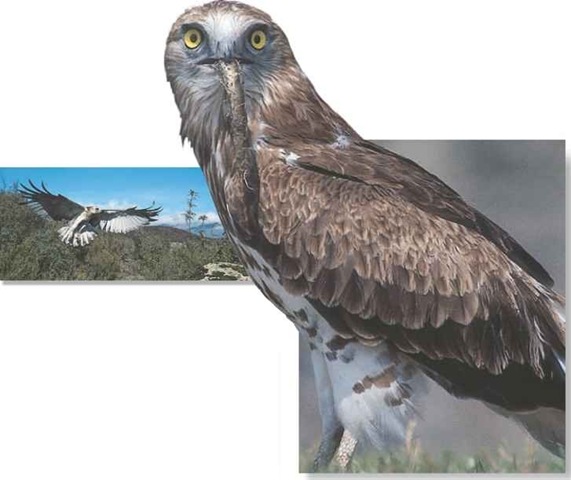
A Rocky range
Form Italy to Iran, Egypt to Estonia, the short-toed snake eagle prefers warm, rocky habitats.
The short-toed snake eagle has been known to attack prey from 1,500′ away — thanks to its exceptional eyesight.
The eagle can kill a 6′-long spitting cobra.
If her egg fails to hatch, a female will incubate for up to 90 days before giving up.
snake specialist
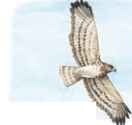
Spotted…
A snake eagle hovers high up in the air, spotting a snake with its keen eyesight. Snakes comprise more than 70% of the eagle’s diet.
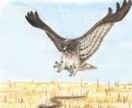
Swoop and grab…
The eagle parachutes on outstretched wings and grabs the snake in its talons.The motion is swift and effective.
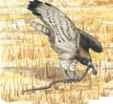
No escape…
Once in the eagle’s powerful clutches, the snake is trapped. Using its sharp beak, the eagle will rip the head off the snake.

Meal in tow
The eagle flies off with the snake’s tail hanging from the bird’s partly opened bill. A waiting mate or chick will feed on the same snake.
Breeding
A powerful flier, the eagle soars to great heights during the breeding season, when it performs breathtaking displays. The male bird begins the courtship dance with a steep climb into the air; it then repeatedly drops in gentle curves before rising again. During the display, the male often carries a snake or twig in its bill, which it drops and catches and then passes to the female. The birds then soar together and conclude with loud pieeou, pieeou and gull-like who-who-who calls.
Pairs mate for life. Each year, the female builds a new nest of twigs and sticks in trees 1025′ above ground, always well hidden from below. The nest is relatively small compared to the size of the bird, with a deep cup lined with green grasses.The female lays one smooth, oval egg that is white and tinted blue. She incubates the eggs alone for 45-47 days, and the newborn chicks are downy-white with gray eyes that later turn a brilliant orange or yellow. Young eagles have very large heads even in the early downy stage. Feathers grow first on the back and head, an adaptation to the nest being exposed to the blazing sun. Both parents feed the chick, which fledges in 70-75 days. Some young fly to nearby branches at 60 days, but after fledging usually leave their parents’ territory.The chick has the instinctive ability to swallow snake prey whole, like the adults. However, very young chicks are fed torn pieces of snakes or lizards.
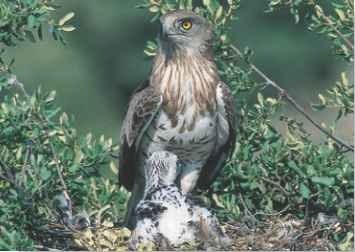
Perching protector A short-toed snake eagle stands guard over its growing chick, while they both await the female’s return.
conservation
The short-toed snake eagle is not globally threatened. Following a long-term decline due to hunting and habitat changes, most countries, including Spain and Russia, report population stability.
Behavior
The short-toed snake eagle is highly territorial and defends its space against intruders. In a threatening display flight, the bird glides with its head fully stretched out and emits a u-ok-ok call.This warning usually prevents intruders from crossing boundaries. After the breeding season, the bird migrates to winter quarters, traveling singly, in pairs or in small groups. European populations winter in the northern tropics ot Africa; eastern populations winter in the Indian subcontinent and Southeast Asia.
Eye spy A snake eagle watches for snakes — or intruders.
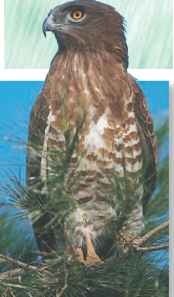
PROFILE
SHORT-TOED SNAKE EAGLE
The short-toed snake eagle stalks its prey from above before gliding to earth to grab its victim, usually a snake, with razor-sharp talons.
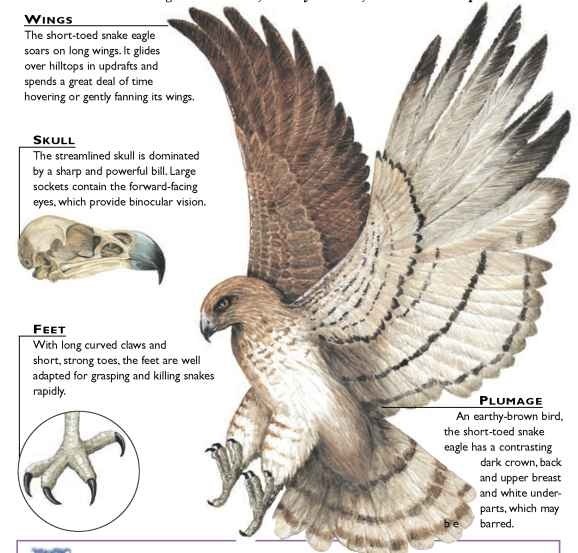
Creature comparisons
Measuring up to 29″, the crested serpent eagle (Spilornis cheela) is slightly larger than the short-toed snake eagle.The crested serpent eagle’s distinguishing features include its large, black fan-shaped crest, rounded wings and white-spotted underparts. Similar to the short-toed eagle in both diet and hunting habits, the crested serpent eagle has a more limited range. It inhabits China and India and prefers evergreen forests, but sometimes lives next to ponds or in hilly country. Both species perch and nest high in the trees and Crested soar over their territory, scanning for prey. serpent eagle

| VITAL | ||
| STATISTICS | ||
| Weight Length | 2.5-5 lbs. 24-27.5″ | |
| Wingspan | 5.5-6′ | |
| Sexual Maturity Breeding Season |
3-4 years Varies with region |
|
| Number of Eggs | 1 | |
| Incubation Period | 45-47 days | |
| Fledging Period | 70-75 days | |
| Breeding Interval | 1-2 years | |
| Typical Diet | Snakes, lizards, frogs, birds and small mammals | |
| Lifespan | 17 years | |
RELATED SPECIES
• The short-toed snake eagle is 1 of 15 species of snake eagles and serpent eagles in 5 genera: Circaetus, Terathopius, ‘ Spilornis, Dryotriorchis and Eutriorchis. The 6 species in Circaetus include the short-toed snake eagle, as well as the Beaudouin’s snake eagle, C. beaudouini, and the black-breasted snake eagle, C. pectoralis. There are 64 genera and 237 species in the family Accipitridae.
